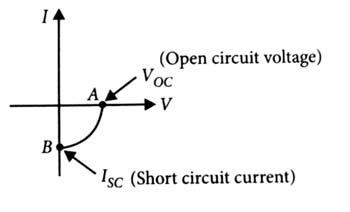Topic Question Set
Q 1
:
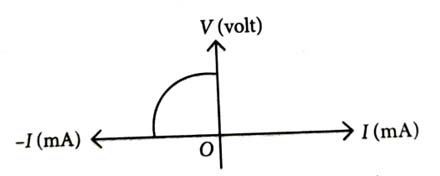
The characteristics shown above are exhibited by a [2024]

light emitting diode
zener diode
photodiode
solar cell
(4)
Solar cell exhibit this kind of characteristics.
Q 2
:
Consider the following statements A and B and identify the correct answer. [2024]
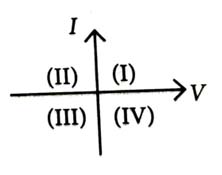
A. For a solar-cell, the characteristics lies in the IV quadrant of the given graph.
B. In a reverse biased pn junction diode, the current measured in (), is due to majority charge carriers.

B. In a reverse biased pn junction diode, the current measured in (), is due to majority charge carriers.
A is correct but B is incorrect.
A is incorrect but B is correct.
Both A and B are correct.
Both A and B are incorrect.
(1)
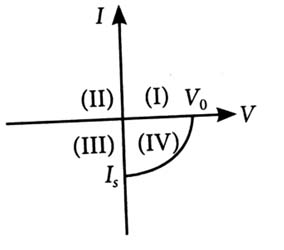
(A) The I-V characteristics of solar cell lies in IV quadrant of the given graph, where current is negative which means that current I is supplied by the solar cell and not drawn by it.
(B) In reverse-biased, p-n junction, the positive terminal is connected to the n-type. Hence, majority charge carriers are swept towards the terminals and minority charge carriers are repelled by the terminals. Hence, a small drift current flows through the diode due to minority charge carriers of both n-side and p-side.
Hence, A is correct but B is incorrect.
Q 3
:
Given below are two statements: [2023]
Statement I: Photovoltaic devices can convert optical radiation into electricity.
Statement II: Zener diode is designed to operate under reverse bias in breakdown region.
In the light of the above statements, choose the most appropriate answer from the options given below:
Statement II: Zener diode is designed to operate under reverse bias in breakdown region.
Statement I is correct but Statement II is incorrect.
Statement I is incorrect but Statement II is correct.
Both Statement I and Statement II are correct.
Both Statement I and Statement II are incorrect.
(3)
Photovoltaic devices convert optical radiation energy into electricity.
Zener diode operates in reverse biased in breakdown region.
Q 4
:
Consider the following statements (A) and (B) and identify the correct answer. [2021]
(A) A zener diode is connected in reverse bias, when used as a voltage regulator.
(B) The potential barrier of p–n junction lies between 0.1 V to 0.3 V.
(A) A zener diode is connected in reverse bias, when used as a voltage regulator.
(B) The potential barrier of p–n junction lies between 0.1 V to 0.3 V.
(A) is incorrect but (B) is correct.
(A) and (B) both are correct.
(A) and (B) both are incorrect.
(A) is correct and (B) is incorrect.
(2)
Yes, zener diode is connected in reverse bias as it is used as voltage regulator.
The potential barrier of p-n junction
For Ge; ; Si;
Q 5
:
An LED is constructed from a p-n junction diode using GaAsP. The energy gap is 1.9 eV. The wavelength of the light emitted will be equal to [2019]
m
654 nm
654
m
(2)
Given, energy gap
Now, for the LED to operate, electrons need to cross this energy gap.
Q 6
:
The given graph represents characteristic for a semiconductor device. Which of the following statement is correct? [2014]
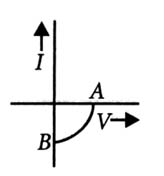

It is V–I characteristic for solar cell where, point A represents open circuit voltage and point B short circuit current.
It is for a solar cell and points A and B represent open circuit voltage and current, respectively.
It is for a photodiode and points A and B represent open circuit voltage and current, respectively.
It is for a LED and points A and B represent open circuit voltage and short circuit current, respectively.
(1)
The characteristic for a solar cell is as shown in the figure.
